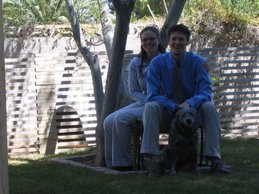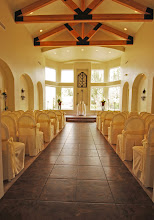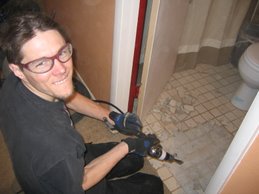After reading all of the different posts, viewpoints and comments that either share the opinion or slightly disagree, I have come to these conclusions. I admit that this has been a fast and intense week of blogging and sharing thoughts, beliefs, perspectives and personal experiences that have truly molded everyone's views. I must admit that I have not always commented back on as many posts that I would have liked to, but I also know that I can quickly become a broken record.
Whatever the opinion may be regarding this essay, I will dare to say that like myself, we have all had an experience either personally or been a close witness to that has been brought to vivid memory. I will also mention that this is in my forethought. How can we, as young adults seeking to be part of the solution to these complex issues, implement “Design citizenship”, provide sustainable buildings, be budget conscience, etc.
(and yes, Tom, I will include you into this grouping, even though you are a experienced Architect seeking to improve your knowledge).
I have mentioned that I live in Vegas (Sin City), but prior to that I grew up in So. California, 60 miles East of Los Angeles. That put me in the middle of San Bernardino, and at that time it was known as the murder and welfare capitol. My childhood neighborhood was extremely "diverse." I didn't grow up in a gated community, then again gated communities were not the big thing. My brother and I and the neighborhood friends played football in the streets like, I sure, many of you all did. We felt very safe.
The first time I remember being "different", and this experience is somewhat similar to that of yours Herb, I was at a minor league baseball game (San Berdiano Spirits, yes I saw Griffey Jr. play before he was big) and was in the parking lot getting a glove or something. A foul ball came my way in the middle of the parking lot and I went for it. There were some others trying to get it, but I made it first and got the prize. That didn't last long as the other boys didn't like that to much and they proceeded to jump me (for those that are not familiar with that term, I was beat up by several people at one time). I guess, looking back at it now with this essay under my belt, I had crossed the "boundaries". The lesson I learned was this: when you find yourself in the wrong area at the wrong time, though it may not be your fault, you tend not to put yourself (especially when you grow up and have your own family) back into those situations. Yes I have heard of "driving while black" but I have also heard of "reverse-discrimination" and there is little talk about how to solve that.
Back to Las Vegas... my wife and I live in a neighborhood that is extremely diverse, where we, as the "white, middle-class" family with one dog are the minority. We know our neighbors, we don't have them over every weekend for dinner and football, but we know them as much as we can while struggling with a language barrier. My neighbors don't feel intimidated by me being a white middle class man. In fact I don't think they really care to know me. Then again, I may be naive to the fact that I really am intimidating them by living next door to them and I just don't know it.
I agree with Bickford, that there is a need to be a better, as Herb put it, "design citizen." I am eager to see where this new insight will lead me.
The terms listed in Heb's previous post:
escape, or moving away from the stimulus (leaving a noisy room, for instance)
division, or erecting a barrier between us and the stimulus (closing a door, for instance)
withdrawl, or body language that indicates you don't want to be disturbed (not making eye contact in the elevator, a group of friends in a close circle that disinvites others from entering, etc.)
anonymity, or going to a place where information flow doesn't matter because people don't know who you are and so the information isn't really linked to a person (every small-town gay kid who grew up and moved to a big city knows about this one)
These are all mental as well as physical items. The journey to resolve the issues will be, as many have already stated, education of not just Architects but City Planners, Developers, Contractors and Investors.
I can expect that, if nothing else, I will be more sensitive to the everyday people that will be part of my future "built environments." The part I am not looking forward to is the "beat down" that is always part of the job when dealing with the all important factor for the owners, developers and city planners: MONEY. That sadly is the reality in which I work.
And now, after 10 hours on the computer today, my wife is strongly suggesting that I close up shop. :)
1.06.2007
Thought provoked...
Posted by
Ken Ballard
at
10:57 PM
![]()
Labels: History/Theory
Subscribe to:
Post Comments (Atom)
Fun Links
- The American Institute of Architects
- AIA Las Vegas
- Suzana Rutar, Architect
- IECC COMcheck-web
- LA Dodgers
- Things to read
- Drivers, start your engines...
- Science is COOL!!!
- The City Tower
- Slovenian World Confrence - Architects and Builders from Slovenia and the World
- architectural studies library UNLV
- ASL Blog
- UNLV Bridge Studio


















1 comment:
Hey, Ken.
I did a little work in San Bernardino, which is the Amarillo of California :-) Actually, Bakersfield (a little further north in the Valley, for those of you from elsewhere) is the Oklahoma City of California... It's Black and Latino and White and everybody hates everybody else and it's flat for a thousand miles in every direction and a hundred and five degrees.
It's interesting to think about the places we've lived and how that's helped to shape who we are. I grew up in Western Michigan (Muskegon), a dying industrial city that formerly made little things like piston rings and wire so that Detroit could make big things. When I was 20, I moved to Amarillo; by 25, I was gone, and living in Oakland and Berkeley. Intellectual and social whiplash!
At 33, graduate school in Milwaukee, then back to California: the far northern coast (Arcata) in my late 30s, the southern coast (San Luis Obispo) in my early 40s, then back for a couple of years to Oakland.
When I was 44, I started teaching at Duke University in Durham, NC. It was my first time in the Southeast, and let me tell you, friends, the Civil War is not over.
Now at 48, I've been in Boston for six months. It's the loudest place I've ever lived -- conversations take place at jackhammer volume. But it's a brick environment, which I love for a couple of reasons -- I grew up with a few important brick buildings in my hometown; I lived in California for a long time, where bricks are increasingly rare (seismic codes); and the degree of detailing is inspiring. One thing I've done for many years as a teacher is to help students see very quickly the difference between brick construction and "brick wallpaper."
There's something intellectually and emotionally satisfying for me about bricks. They imply permanence. The structural system is visible. The patterning is endless. The material has a tactile delight. The coloring is inherent rather than applied. They have the marks of handwork, and the craftsmen who make them have to have more skills than some guy with a pneumatic nailer. That's one reason why, for me, Boston is a visual delight.
Post a Comment